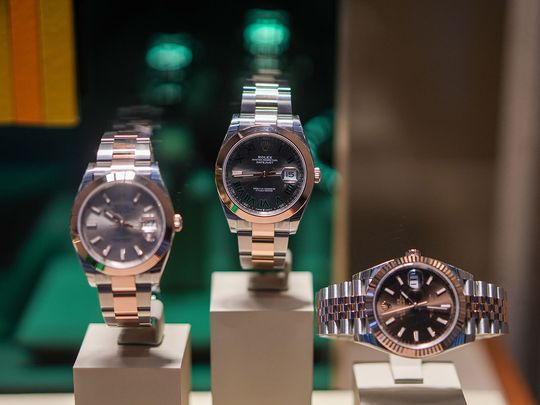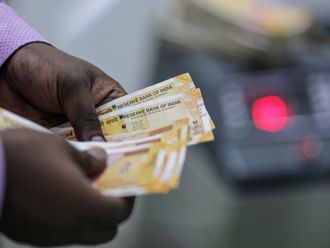
Dubai: With cryptocurrency adoption, demand for luxury goods, particularly luxury watches, skyrocketing since 2020, there has been a growing imbalance between supply and demand in the high-end timepiece market. But how can you, as a buyer, capitalise on this trend?
This phenomenon is especially notable among luxury Swiss brands such as Rolex, Audemars Piguet and Patek Philippe. In this context, the luxury watch market in the Middle East, particularly in the UAE, has been experiencing an unprecedented boom.
According to global research specialists Statista, the region is expected to see a compound annual growth rate of 2.62 per cent by 2028, surpassing the global growth of 2.25 per cent. For high and ultra-high net worth individuals in the Middle East, this presents both opportunities and challenges worth noting.
What is currently trending among luxury watches?
Stainless steel and rose gold watches have long dominated the luxury watch market, driven by the legacy and prestige of renowned manufacturers like Rolex, Audemars Piguet and Patek Philippe. Interestingly, the market is now witnessing a new phenomenon: Collaborations.
Brands are teaming up with luxury goods companies, artists, and designers to create unique, limited-run pieces that generate significant buzz. For instance, the recent collaboration between Patek Philippe and Tiffany & Co. led to a limited-edition watch that sold out instantly, highlighting this growing trend.
Customising luxury watches: Sound idea for buyers?
Customisation of luxury watches offers a way to express individuality, but it significantly reduces a watch's value. Any modifications, particularly those done by third-party jewellers, can void warranties and drastically decrease resale value.
For example, adding aftermarket diamonds might seem appealing but can substantially lower the market value of the watch. However, if personalisation is still desired, it is recommended to opt for manufacturer-approved customisations. While this approach may not help preserve the value, it will certainly ensure that the timepiece remains under warranty from the manufacturer.
How do buyers choose which luxury watch to go for?
When it comes to selecting a luxury watch, buyers often face a dilemma: Personal taste versus investment and resale value.
With today’s buyers turning to credible global sources such as chrono24.com and watchfinder.com for information and advice on purchases, high and ultra-high net worth individuals often lean towards pieces that promise strong resale value.
Collectors, for instance, ensure they keep ‘box and papers’ to maximise resale potential. Some savvy investors buy with the sole intent of flipping the watch for a profit, capitalising on market demand without ever wearing the piece.
Getting the watch of your choice doesn’t come easy
Buying a luxury watch today is no simple feat. The booming market means that walking into a brand boutique and buying your desired model on the spot is nearly impossible.
For instance, according to Bloomberg, Dubai Mall’s Rolex boutique had a waiting list of a staggering 4,000 customers in 2022, and there are strict protocols mandated by such luxury watch brands for would-be purchasers.
Enthusiasts with an existing collection will already be on the manufacturer’s list of eligible buyers, with their eligibility to buy limited-edition or high-demand pieces determined by the extent of their collection.
Individuals that are not on these lists have two options to secure a coveted piece; buying from a reputable reseller for a premium, which could be at least 50 per cent higher and, in some cases, double the retail value, or finding out their chosen brand’s protocol and following it. This could involve buying one, two or more of the less popular watches in order to then be eligible to buy their watch of choice.
Protecting your assets is key for luxury watch owners
Given the immense value of luxury watches, which can reach hundreds of thousands of dollars, proper protection against theft or accidental damage is crucial. For high-net-worth individuals, these watches are not just investments; they symbolise success, preference, and personal history.
Insuring them is essential not just for their monetary worth but also for the memories they hold. The loss of such items without proper coverage can be both financially and emotionally devastating.
General home insurance may offer some coverage, but dedicated policies from experienced private client insurers provide tailored solutions. These insurers not only cover high-value timepieces but also offer expert advice on storage, security, and safe travel, ensuring comprehensive protection.
Additionally, luxury watches often appreciate over time, making it even more crucial to ensure they are adequately insured. As the value of your watch collection grows, it's vital to regularly review and update your insurance to ensure full protection. A comprehensive insurance policy ensures that you're fully protected against unforeseen events, giving you peace of mind.
Luxury watch owners can also choose to insure their timepieces under their home insurance, or purchase a specific policy for a higher premium.
What luxury watch shoppers can eye in the future
The future of the luxury watch market looks promising for astute investors. Reports indicate that secondary market sales can fetch up to 300 per cent above the original retail prices.
With predictions from Swiss experts LuxeConsult suggesting the secondary market will triple in size over the next decade, surpassing the primary market, well-informed investors with desirable, untouched timepieces complete with ‘box and papers’ can anticipate significant returns.









